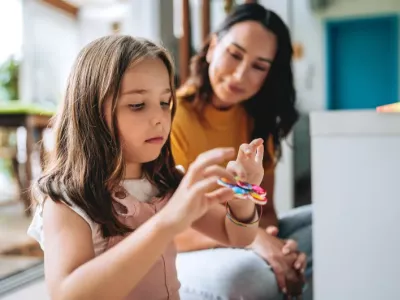How to set social media rules and boundaries the whole family can live with

If you’ve been worried by your child’s exposure to social media, you’re not alone. Navigating social media with kids can feel overwhelming, and for good reason. Our 2024 survey showed most parents are worried about the impact of social media on their child’s mental health. Nearly all of those who allowed social media access reported regular conflict over its use.
Why is it so hard to set social media boundaries?
It's tough when technology moves faster than parenting advice. You might be wondering how to explain social media and its dangers, or how to set realistic rules for kids, tweens and teens.
The good news is that research shows that when parents set limits, monitor children’s use and reduce their own social media activity, kids are less likely to have problems with social media.1
Social media age restrictions
A few countries around the world are implementing tougher age restrictions around social media usage. It could be a great conversation starter for your family. To help kids understand, talk about the reasons for the boundaries, what parental controls might look like for your family, model healthy habits and seek help when needed.
Whether your child is on social media or not, it’s a good opportunity to have a gentle family conversation about rules and boundaries and what these might look like for your family.
1. Open and honest conversations – a gentle parenting gateway
Open, honest, calm conversation plays a big part in creating a safe, judgement-free household where children can share their views and concerns without risking punishment or being shut down. If you’re prepared, a conversation around social media and its impact on mental health will strengthen your family relationships. It can have upsides like more time in healthy connection with each other and less stress on you, as a parent or caregiver.
2. Modelling healthy social media habits for less stress
Parenting in the digital age is challenging, so be kind to yourself. Aim for progress rather than perfection. Talk to friends, teachers and other caregivers about their approach to social media boundaries and rules.
Remember that your kids take their cues from you and set an example. Also try showing a relaxed interest in your child’s screen use. Praise them for good choices. Reassure them that you’re there to help if they come across anything that confuses, worries or upsets them.
3. Educating kids on the dangers of social media
You might be wondering, ‘How can I convince my child to use social media apps less? Where can I start?’ Try short and frequent conversations about the potential harms. Explain that screens are designed to keep us coming back for more and it can be hard to stop. Do they know that algorithms profile and target them? How scammers can turn a seemingly innocent click into an empty bank account?
Your children might already be aware of cyberbullying. Talk through ‘what if’ scenarios and ask them how they would feel and what they would do if it happened to them.
Don’t forget to talk about the healthy aspects and reasons that they use social media. Is it mostly about connecting with friends? How else can they stay in touch with friends and family?
4. Creating realistic social media rules for kids
It's normal to feel uncertain about social media rules or expectations. You might be wondering, ‘Practically, how do you stop kids going on social media sites?’ At some point kids are going to come across social media. Have a conversation about your family goals, values, and ideas. Listen to what kids think and come to a decision together about the rules and boundaries that work for your family.
Consider these questions as a starting point:
- What apps are allowed in our family? Is YouTube Kids or watching dance, science or funny videos on someone else’s account okay?
- Should we have device-free zones, like our bedrooms? How will we listen to music or set alarms?
- If you only had one hour of screen time per day, what would you choose?
One of the most important things is reaching a family tech agreement that the kids have had a say in and feel ownership of. They are far more likely to cooperate if they have been part of the process, understand the reasons for the rules, and have been listened to2.
Bear in mind that it’s easier for kids when they know what’s expected of them, and when household rules are clear and consistent. Consider talking with grandparents, co-parents, family and friends about your values and rules, and how you can work together. Remember to praise kids when they follow rules and limits.
5. What about consequences?
A common question is, ‘What happens if kids ignore boundaries?’ Consequences are best used when they are brief and related to the skill we are trying to teach. For example, you notice your child using a social media app they are not allowed. As a consequence, you remove the device for 10-30 minutes. Then you give it back and encourage them to stay within the family rules.
On the other hand, holding these boundaries can be really challenging. Sometimes children might pester you to change your decision, which could be ‘No social media in our house.’ Remind them that the family made the decision together and that you’ll be sticking to it. Acknowledge that you can see it is frustrating for them and encourage them to find other things to do. Try to take some time to think about what might help you, or what has helped in the past, to hold that boundary calmly.
As a parent, you don’t need to be a social media expert. Setting social media rules is about protecting your child’s and family’s mental health. It’s all about working towards a healthy, balanced lifestyle to help your family thrive.
Social media: where to seek help
Triple P programs can help with parenting strategies that support your children’s resilience and wellbeing, including adjusting to social media age restrictions.
- For families of children aged 12 and under, Triple P Online can help.
- For support with teens, you could try Teen Triple P Online.
Visit the Canadian Paediatric Society’s Centre for Healthy Screen Use and Gouvernement du Québec’s page on Balanced screen use for children and teens.
References
- Nagata, J.M., Paul, A., Yen, F. et al. (2025) Associations between media parenting practices and early adolescent screen use. Pediatr Res, 97, 403–410. https://doi.org/10.1038/s41390-024-03243-y
- 2. Symons, K., Ponnet, K., Vanwesenbeeck, I., Walrave, M., & Van Ouytsel, J. (2019). Parent-Child Communication about Internet Use and Acceptance of Parental Authority. Journal of Broadcasting & Electronic Media, 64(1), 1–19. https://doi.org/10.1080/08838151.2019.1681870

